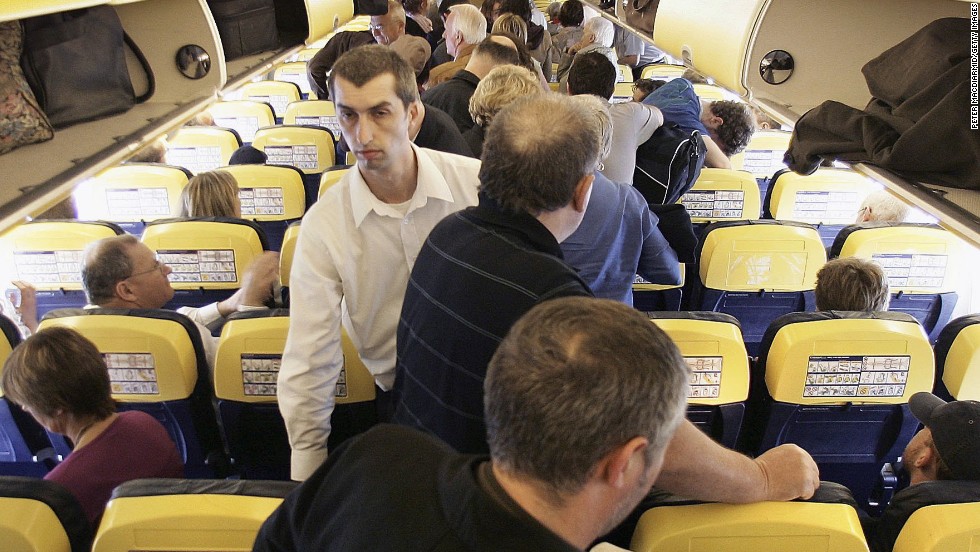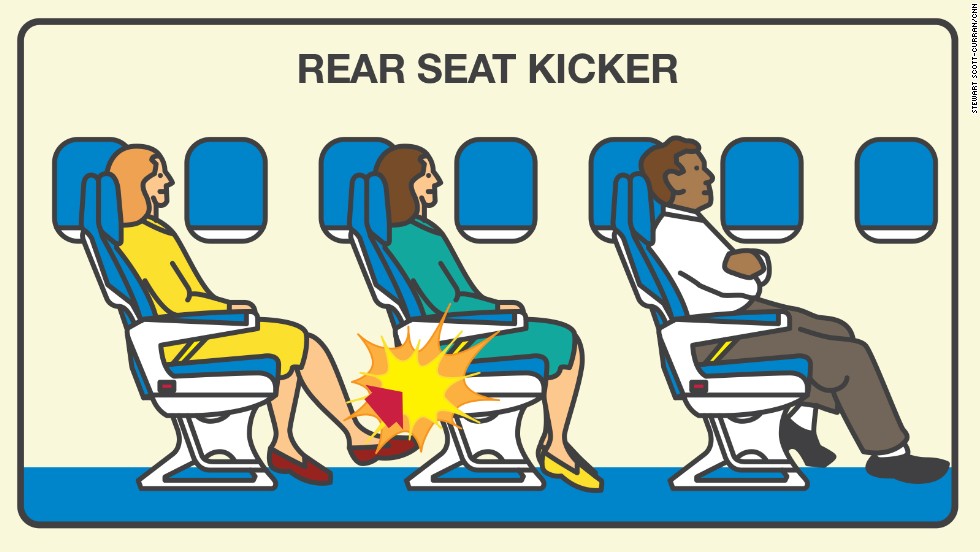Air rage triggered by walking past first-class seating, study says

10 photos: Aggravating fellow fliers
6. Big-time small talk – You may be excited to meet new people on your flight, but 43% of fliers find in-flight chatterboxes annoying.
Hide Caption
6 of 10

10 photos: Aggravating fellow fliers
7. Gross overpacking – Carry-on
baggage offenders delay everyone by trying to pass off their 40-pound
duffel bags as "personal items." Nearly 40% of fliers object.
Hide Caption
7 of 10

10 photos: Aggravating fellow fliers
8. Springing into action – The
queue jumper rushes to deplane, thinking those few extra minutes are
more important for him than anyone else. And that's why 35% are
irritated.
Hide Caption
8 of 10

10 photos: Aggravating fellow fliers
9. Relaxation at any price – The
seat-back guy, aka the seat recliner, doesn't care about the impact of
his recline on the people behind him. More than 30% of fliers are
annoyed.
Hide Caption
9 of 10

10 photos: Aggravating fellow fliers
10. First come, first served – The inconsiderate overhead bin user stows his bag in the first available spot. That kind of behavior annoys 32% of fliers.
Hide Caption
10 of 10

10 photos: Aggravating fellow fliers
1. Feet of fury – Passengers
who use their feet as weapons topped Expedia's list of onboard
etiquette violators in its 2015 Airplane Etiquette Study. Just over 60%
of those surveyed find rear seat-kickers very annoying.
Hide Caption
1 of 10

10 photos: Aggravating fellow fliers
2. Dereliction of duty – Parents
who seem to forget they are flying with children dependent on them for
snacks and entertainment are a nuisance to 59% of those surveyed.
Hide Caption
2 of 10

10 photos: Aggravating fellow fliers
3. Unwashed masses – Stinky passengers are objectionable to 50% of fliers.
Hide Caption
3 of 10

10 photos: Aggravating fellow fliers
4. Audio assaults – Passengers who talk, play games or listen to their favorite songs or shows at top volume aggravate half of those surveyed.
Hide Caption
4 of 10

10 photos: Aggravating fellow fliers
5. Aggravating indulgence – If you can't remember your flight, you might be a boozer. Boozers are unpleasant to 45% of surveyed fliers.
Hide Caption
5 of 10

10 photos: Aggravating fellow fliers
6. Big-time small talk – You may be excited to meet new people on your flight, but 43% of fliers find in-flight chatterboxes annoying.
Hide Caption
6 of 10

10 photos: Aggravating fellow fliers
7. Gross overpacking – Carry-on
baggage offenders delay everyone by trying to pass off their 40-pound
duffel bags as "personal items." Nearly 40% of fliers object.
Hide Caption
7 of 10

10 photos: Aggravating fellow fliers
8. Springing into action – The
queue jumper rushes to deplane, thinking those few extra minutes are
more important for him than anyone else. And that's why 35% are
irritated.
Hide Caption
8 of 10

10 photos: Aggravating fellow fliers
9. Relaxation at any price – The
seat-back guy, aka the seat recliner, doesn't care about the impact of
his recline on the people behind him. More than 30% of fliers are
annoyed.
Hide Caption
9 of 10

10 photos: Aggravating fellow fliers
10. First come, first served – The inconsiderate overhead bin user stows his bag in the first available spot. That kind of behavior annoys 32% of fliers.
Hide Caption
10 of 10

10 photos: Aggravating fellow fliers
1. Feet of fury – Passengers
who use their feet as weapons topped Expedia's list of onboard
etiquette violators in its 2015 Airplane Etiquette Study. Just over 60%
of those surveyed find rear seat-kickers very annoying.
Hide Caption
1 of 10

10 photos: Aggravating fellow fliers
2. Dereliction of duty – Parents
who seem to forget they are flying with children dependent on them for
snacks and entertainment are a nuisance to 59% of those surveyed.
Hide Caption
2 of 10

10 photos: Aggravating fellow fliers
3. Unwashed masses – Stinky passengers are objectionable to 50% of fliers.
Hide Caption
3 of 10

10 photos: Aggravating fellow fliers
4. Audio assaults – Passengers who talk, play games or listen to their favorite songs or shows at top volume aggravate half of those surveyed.
Hide Caption
4 of 10

10 photos: Aggravating fellow fliers
5. Aggravating indulgence – If you can't remember your flight, you might be a boozer. Boozers are unpleasant to 45% of surveyed fliers.
Hide Caption
5 of 10










Story highlights
- The presence of first-class seating was more associated with aggression than small seats and delayed flights
- Experts caution that other factors could increase the risk of air rage on flights with first-class sections
(CNN)What
is it about air travel that brings out the worst in us? We squabble for
space in the overhead compartment and on the armrest. Some passengers
have even been caught kicking each other and screaming at the flight crew, as YouTube videos bear witness.
A
new study suggests an unexpected trigger for these rare cases of air
rage. It found that passengers in economy seating were 3.84 times more
likely to have an incident of air rage if they were on a plane that had a
first-class section. They were 2.18 times more likely to have an
outburst if they had to walk through first class to board the plane, as
opposed to boarding in the middle of the plane, directly into the
economy section.
"Psychology
(research) tells us that when people feel a sense of deprivation and
inequality, they are more likely to act out," said Katherine A.
DeCelles, associate professor of organizational behavior at the
University of Toronto. DeCelles is the lead author of the study, which
was published on Monday in the journal Proceedings of the National Academy of Sciences.
Passengers
are probably not even consciously aware of the deprivation and
inequality, and how much it is stressing them out, DeCelles said.
However, she and her colleague were not able to talk with the enraged
passengers to get a better idea what set them off.
There
was also a nearly 12-fold increase in the rate of air rage among
first-class passengers on flights where all passengers boarded through
the first-class section, compared with flights that had separate
entrances for first class and economy.
"When
people from higher social class backgrounds are more aware of their
higher status, they are more likely to be antisocial, to have entitled
attitudes and to be less compassionate," DeCelles said.
The
researchers looked at a database from a large international airline
that collected information on air rage during several recent years.
DeCelles and her colleague could not reveal the identity of the airline
or specify the years or exact number of air rage cases because it could
be used to identify the airline.
Overall,
cases of air rage were rare. For every 1,000 flights on planes with a
first-class section, there were 1.58 incidents of air rage in economy
and 0.31 in first class, adding up to a total of a few thousand cases of
air rage during the several-year period. However, flight crews might
not have reported every case of air rage, so the real number could be
higher, DeCelles said.
Flight crews
categorize air rage in one of several types: belligerent behavior,
emotional outburst, noncompliant behavior, and incidents involving
drugs, alcohol, smoking or sex. The researchers found that belligerent
behavior, such as an expression of anger, and intoxication were more
common in first class, whereas emotional outbursts, such as a panic
attack, were more common among economy passengers.
Is air rage on the rise?
According to news reports, the rate of air rage has been on the rise
in recent years. But confirming the rise, and putting numbers on it, is
tricky because the Federal Aviation Administration, which tracks this
information, does not require
flight crew to report air rage. The airline DeCelles studied did show a
significant increase in reports of air rage over the years they
investigated.
Of all the indignities of air travel, the crowds and tiny seats in coach take most of the blame
for inciting air rage among travelers. Yet in the current study,
DeCelles said, the presence of first-class seating was a better
predictor of air rage than the more notorious hassles of flight delays
or having scant room between you and the seat in front of you. And the
researchers found the nearly fourfold increase in air rage cases after
controlling for other factors such as small seats, flight delays and
longer flights.
"It could be a
ceiling effect (with the small seats)," DeCelles said. "You are already
feeling super cramped and that extra half-inch is not going to make that
much of a difference."
Is first class really to blame?
Although
the presence of first-class seating could predict air rage, it is not
clear from this study if it is actually contributing to this behavior,
said Michael McCullough, professor of psychology at University of Miami.
"There
could be another thousand things associated with the presence of
first-class seating" that are piquing air rage, said McCullough, who was
not involved in the study. For example, even though the researchers
took into account the size of the economy cabin, there could be features
of planes that do not have a first-class section that make people feel
less pressure and less like they are being treated like cattle, he
added.
"Extraordinary claims
require extraordinary evidence. (This study) is provocative, but it does
not strike me as an open and shut case," McCullough said. If the
researchers are actually right that the presence of first class, or
having passengers walk through first class, contributes to the risk of
air rage, "someone ought to insist we change the way we structure planes
... some of these incidents really are public hazards," he said.
In
extreme cases, flights have to be diverted or law enforcement has to be
called onto the aircraft to handle an unruly passenger.
It
could be possible to have more planes load passengers in both the
middle and front of the aircraft so travelers do not see passengers in
the other section, DeCelles said. "Most aircraft do have doors in the
middle, from what I am told from airline executives," she said. The
bigger issue is whether the airport has the capability of attaching two
jetways to the plane.
In addition
to reducing the incidence of air rage, boarding at the front and middle
of the plane could probably also make the entire process of boarding go
faster, DeCelles said.





No comments:
Post a Comment